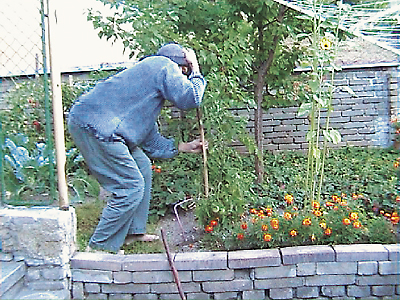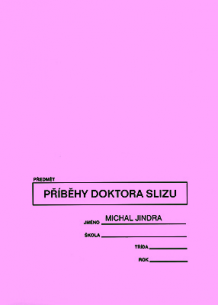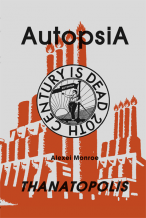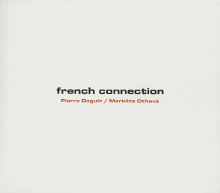| Umělec magazine 2003/2 >> The walking staff, or a report from an Albanian salt walk | List of all editions. | ||||||||||||
|
|||||||||||||
The walking staff, or a report from an Albanian salt walkUmělec magazine 2003/201.02.2003 Martin Zet | albania | en cs |
|||||||||||||
|
Z-topos: LIBERATING WALK
I haven’t read Sir Thomas Moore. What does the letter “U” in the word Utopia mean? If it comes from “universalis” — then utopia means Universal place. A place of universal order. As representation of the idea of a universal solution, as product of the idea of the possibility of universal description, universal knowledge, of the possibility of embracing universal knowledge. As product of the idea of the possibility of building a world universal order. Which doesn’t always mean building a place of ideal order. Nobody ever speaks about Itopia (idealis). History so far has shown that the universal solutions haven’t worked so well on the level of the individual. And also individual solutions work only under certain conditions. They shouldn’t harm the people around. And the nature around. The universe. I want to experiment to see how it could be living and acting in a smaller mental place than a universal one. F-topos (familiaris), or another I-topos (individualis). And then the place which is my very own place, Z-topos. I want to try to focus on my place and experience, at least once doing something which does not harm the people around. To forget my sharpness, my inclination to be inside conflict situations, to scream. I would like to try to fight with myself in my (Z) place to discover and liberate another layer of myself. How to do it? Who in history was able to act in a way that suits this approach? How to demonstrate a desire for personal/universal freedom, not on the account of somebody else? The dream and the will? Not so many examples in recent history. Not so many suitable examples. I arrive in Tirana. Meet friends, and new people, drink, socialize, enjoy being there. When the time ripens to certain point — after some (not very mysterious) rituals (something with body hygiene, or changing clothes, etc…) — I quit the crowd, dressed in something very simple (or, on the other hand, in a Czech folk costume — which I have never worn), in sandals or barefoot, the pilgrim’s staff I walked the Himalayas with in hand (since then my wife started to use it in the garden as a prop for tomato plants). I start walking through the country (from the north, where the Kosovar refugee camps were — to see how they look after four years — to the South, or just from Tirana to the sea — but not the shortest way). Maybe not speaking, maybe not eating, depending on the atmosphere around. Trying to be as little theatrical as possible. No money, no documents. When I get to the sea I shall try to make some salt from the water — to state the superiority of the elementary over the sophisticated. Then I will go back, speak and eat and drink with people and wait for a moment to put that salt on the food (bread) they/we will eat. Martin Zet 22 June 2003, Libusin Some objects only reveal their importance to me in time. When I picked up a piece of wood (it was sometime in April 1993, somewhere in the Himalayas, I don’t remember anymore) I didn’t know the importance it would have for me later, or that it could become a motive. I only needed to lean on something, as I was tired from walking. And I didn’t know that the sketches and texts which I made along the way would later look like a compact “project.” I even went there with the completely opposite goal: to forget everything, including the world of art. Another model situation can demonstrate that, if I am an artist at all, I am a post-conceptual artist. At least in the sense that, in most of my works, the unifying inner connection or concept reveals itself only during its process, sometimes even afterward, sometimes many years later. I took a few pictures with the staff at an altitude of 5,630, and at the black rock of Kala Pattar (5,475), where I played with instability and scale, with the relation of the size of tangible things, the human need for the construct of measurement and the limited measurability of towering mountains. I don’t know why I took it home with me. I simply couldn’t throw it away. I got used to it in the mountains — it was pleasant to walk with it. It was exactly the right size, was light and solid. In spite of that, I never used it again. Only now, ten years later, I remembered it, and it seemed important to me to find the staff and take it with me on a trip (a liberating trip) to the sea, in this pettier (and self-centeredly solitary) simulation of a Ghandi march. I had dreamt of doing this for more than three years, from the very beginning of FREE MARTIN ZET!, since June 2000. I originally planned a 500-kilometer journey through India (I wanted to start from Orissa, from the place where Sovan Khumar lives). When this didn’t work out, I waited, I contemplated, I hoped. With the increasing distance it seemed more and more important to me that I just do the whole thing, which was a good sign. Some obsession-making, urgent thoughts surprisingly disappear with time, fade. Coldly rational. This wasn’t (and for me this was unusual) a spontaneous decision. It was a rational decision — if this expression can be used in connection with my thought processes. I had chosen the place and the context. Now only Albania and U-Topos seemed right. On the morning of 6 September 2003, I waited for dusk (I had nearly finished packing my things). I took my Himalayan walking staff from the garden (Erika had been using it to prop up the tomatoes), replacing it with a wooden spear. (I found it in the attic where we had stowed it safely away from our boys just after they made it.) I washed off the soil, finished packing my suitcase and set off for Albania. At 10:22 a.m. it fell out of the luggage cart in the airport and the part that had been in the ground all summer snapped off. (“The fact is, my support had become an illustrative object, only I want to refer to my drinking of alcohol, to my last attempt to stop drinking — this time from midnight on Monday [1 September 2003]. Not even the free alcohol on the plane. But because I don’t believe in its long duration, I welcome any metaphor of support. But my problem is more social than purely alcoholic. I like not hiding my weaknesses. I like being among people. I like losing control among them.” September 6, 10:48, Praha - Ruzyň) 11:19 a.m. Alois Kučera from airport security wanted to confiscate the staff (he called it: a stick) (it is true that the broken-off part didn’t look very good). But luckily a nice Ms. Karolína Špičková from Alitalia saved me — already worked up into a pretty good rage — and even rewarded me by bumping me up to first class (she advised me that I had better limp with the stick). In the Alitalia magazine Agrigento there was an article: “Learning About Salt” (by Ferdinando Maurici?) about the salt mines in Sicily and the role and use of salt in life and in religious rituals, full of exalted sentences like: “The silence of salt and the movement of each single grain have a slow, enveloping, penetrating effect.” Or: “…the salt has been waiting for millions of years to be ‘cultivated’ and ‘harvested’ for the marketplace.” But this as well: “In Homer’s Iliad, salt is the ‘divine substance’ that brings man closer to the gods who, according to Plato, loved salt as a sacred thing, and thus befitting them.” And: “Egyptians, Greeks and Romans invoke the gods by mixing salt with pure water, and the Christian tradition of the holy blessing bestowed by priests in the name of God and the Holy Trinity has been tracked back to this remote origin. For centuries, salt was a form of payment for services rendered, like ready money, such was its importance in the life of a family, starting from the ‘sacred’ mixture of flour, water, salt and natural rennet used to make bread. “Today in many languages the word ‘salary’ means the wages received for work. Until not very long ago, an ancient Welsh tradition involved placing a plate of bread and salt in a dead person’s tomb. A sort of holy man would then eat some of the salt to signify that the dead man’s sins had been consumed before his final departure from earth.” (Joyous news for sinners: There is still enough salt on the earth!) I have heard of it having an important role in the funeral practices of the Gypsies. (“The bark is peeling off, showing old grayish and new pale wounds.” 6 September 2003, 4:18 p.m., Tirana) The suitcase with the necessary things arrive in Tirana three days later and depreciated the very reason for my early arrival — ample time. Under time pressure, I modified my journey. I put off the visit to the former refugee camps. It was not possible to combine this with two new internal demands, which were becoming increasingly more important to me: I wanted to walk without money and without the trappings that would allow me to document what I was doing. On September 9 I set off at about 7:30 a.m. (without a mobile phone or watch — so all time data are rough estimates only) no food no money no documents and the most difficult — no camera determined not to speak during the whole action, unless necessary. (Which I managed except for catching myself moving my lips a few times while articulating the names of the cities and villages as I read the map.) All this was not meant as a limitation, but as a means of liberation, disengagement. That is why nothing was intended to be invincible, strict, irrevocable. Rather, it was a possibility, a variant. The fact I was able to do it this way was mostly accidental, due to the peculiar, reserved tact of the people I met who, when our approach came to a greeting, only mutely initiated or returned a nod. Of all the rubbernecks on the beach, just one lady dared to ask me what I was doing. (To stop her insisting, it was enough to point at my lips and shake my head.) I’m leaving now — two bottles of drinking water, a cake pan, two plastic bags to put it in, matches, lighter cubes, a sweater, a needle and a thread to sew back together my ruined sandals (without them it would be rough going on sharp rocky side paths), a cap, a thoroughly scrubbed glass for instant coffee and three plastic film containers. I reached the sea after eight and a half hours of walking. The boiling water evaporated and a surprising amount of salt was left behind. According to a map of salinity of the world’s seas, the Adriatic contains 38.30 g. of salt dissolved in 1 kg of water. An amount that I thought would take maybe two or three days was actually (in the light of a new full moon) ready in four hours. Once again I was considering, this time, whether I should stay longer (I knew that it would be good for the whole outer feel of the action — time durations usually impress people, and I myself didn’t want to leave the sea), but there wasn’t the pressure of necessity anymore. On the third day I pounded the first batch to dust, the second I left in the pan and even exhibited it like that. At first, I offered the salt as it was, later, now in a salt shaker I sprinkled it on Czech and later Lithuanian bread. (Sadi Groner — a filmmaker from Israel — asked me belligerently: “Are you a Jesus, or what?”) And then once again as it was. At a dinner the salt stood on the table and was used to season the dishes. Part of it I passed around (and I still do) for scattering and salting away into the world. Amir Borstein (and now it is starting to look like I talked only to Israelis in Tirana) told me about the Arabian tradition of offering salt and that its ability to preserve symbolizes the durability of friendship. When buying the salt shakers (the second one got broken when I was showing it off in front of Gallery e Arteve), I asked for the receipt with the idea that I might later get my money back (after all, it was a salt shaker for the biennial). The girl was so surprised by my request that her first attempt to stamp the ripped-out paper covered in writing ended with her stamping her own palm. This made the paper more important to me than the sum mentioned on it, and I never got my money back. (And I also knew that I need these objects to visually document the fragility of the story.) I limped through the airport controls with the salt and the staff without any problems back to Prague. To Libušín I didn’t need to limp anymore. Libušín, 17 September 2003 “Project” — the word deserves a refresher. You cannot simply apply it to everything, but it is becoming a new discipline. “Project” — as a goal, “project artist” — an artist who makes projects. But the tool that allows non-clinging to one type of expression also binds with its regularities. Projects force their creators to create within a certain structure. As a result, a single project by project artists shows some common features, once again resembling group creation. A project artist, whether self-declared or considered thus by others, can get into equally ridiculous situations as mine. Although I take some steps only out of the stinging need to change something in my life, even the people closest to me suspect that I am making a new project and involving them in it without asking their permission. P.S. I think I forgot to mention that on the morning of September 9 — in the hell of a self-documentarist’s decision-making on whether to take the video camera or not — I completely forgot about the walking staff. So on the journey from Tirana to the Adriatic Sea, I walked without it. ALBANIAN (liberating) FULL MOON SALT, made also FOR YOU September 9, 2003 from the Adriatic Sea by Martin Zet after the eight and half hour lasting walk from Tirana to the coast, relieving walk without talking, eating, documenting, no money or documents in pocket.
01.02.2003
Recommended articles
|
|||||||||||||
|
04.02.2020 10:17
Letošní 50. ročník Art Basel přilákal celkem 93 000 návštěvníků a sběratelů z 80 zemí světa. 290 prémiových galerií představilo umělecká díla od počátku 20. století až po současnost. Hlavní sektor přehlídky, tradičně v prvním patře výstavního prostoru, představil 232 předních galerií z celého světa nabízející umění nejvyšší kvality. Veletrh ukázal vzestupný trend prodeje prostřednictvím galerií jak soukromým sbírkám, tak i institucím. Kromě hlavního veletrhu stály za návštěvu i ty přidružené: Volta, Liste a Photo Basel, k tomu doprovodné programy a výstavy v místních institucích, které kvalitou daleko přesahují hranice města tj. Kunsthalle Basel, Kunstmuseum, Tinguely muzeum nebo Fondation Beyeler.
|





































 New book by I.M.Jirous in English at our online bookshop.
New book by I.M.Jirous in English at our online bookshop.
Comments
There are currently no comments.Add new comment